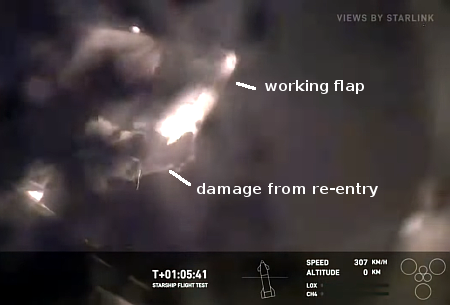
Damaged but working flap on Starship
SpaceX this morning successfully launched and landed both Starship and Superheavy in the ocean, with both vehicles splashing down in a vertical position as planned.
Some quick details:
- One engine on Superheavy failed during launch, but the vehicle completed its job, successfully releasing Starship as planned.
- Superheavy then completed a controlled splashdown in the Gulf of Mexico, landing softly and vertically. It then tipped over into the water as planned. At this moment it is unclear how successful it was in landing precisely at its planned location. One engine during the landing burn failed.
- Unlike the previous test, Starship flew under control for its entire flight, even though the camera view showed a flap actually begin breaking up.
- That flap, despite damage, appeared to function through landing. The screen capture to the right was taken just before landing, as the flap adjusted its position despite the significant damage near its attachment point to the ship.
- It appeared that Starship successfully completed its flip to vertical just before landing.
- At landing it was unclear if the landing burn occurred as planned. It did appear the spacecraft splashed down softly, and the controllers announced the burn occurred, but the indicators on the screen showed no engine burn.
Overall, this launch was an incredible success. Based on the results, the fifth test flight should be approved by the FAA relatively quickly. The FAA’s responsibility is supposed to be limited to just issues of safety. As long as SpaceX demonstrates the rocket landed where it was intended, the FAA has no cause to delay future approvals.
If so, the next launch could occur very quickly, as the next prototypes are ready and waiting. We could see another launch within two months, at the most. I predict late July, though it could be a bit later if SpaceX engineers need more time to analyze what happened to Starship during descent and then apply that knowledge to the next prototype.
UPDATE: China also had a successful launch this morning. Pseudo-company Galactic Energy’s Ceres-1 rocket placed three satellites into orbit, lifting off from the Jiuquan spaceport in the northwest of China.
Little information was released by China’s state-run press, which didn’t even bother to mention the pseudo-company’s name in its report. The solid-fueled lower stages landed somewhere inside China, but we have no idea where or how close to habitable areas.
The leaders in the 2024 launch race:
60 SpaceX
27 China
8 Russia
7 Rocket Lab
American private enterprise now leads the world combined in successful launches, 70 to 41, while SpaceX by itself leads the entire world, including other American companies, 60 to 51.
Note that for context the U.S. total at this moment, 70 launches and achieved in less than half a year, matches the nation’s previous annual record set in 1966 and held until 2022.


